Slovenia is likely to be one of those destinations that you will have heard of, but might not be able to locate 100% accurately on a map. Despite its diminutive size, it’s home to two of the world’s greatest road cyclists - Tadej Pogačar and Primož Roglič. Is it just a destination for roadies though, or should lovers of away-from-the-road riding add it to their bucket list too? Olly headed there with his wife and a couple of gravel bikes in order to find out.
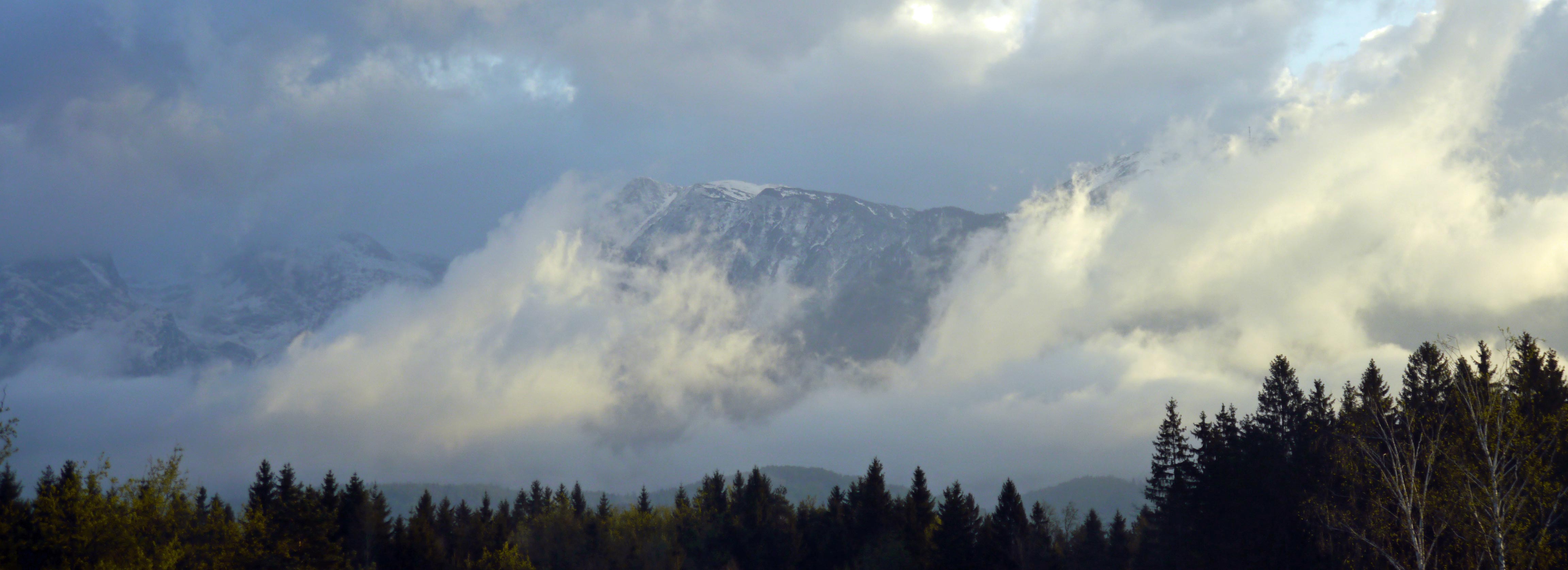
When we told our friends and family that we were going to Slovenia for our summer holiday, they almost universally replied “Oooh, that sounds great. Where exactly is Slovenia again?” Bounded by Italy to its north-west, Austria to the north, Hungary to the east and Croatia to the south and south-east, the diminutive Republic of Slovenia is a mountain lover’s paradise. Slovenia covers 20,000 km2 (~8,000 miles2) and has a total population of just over 2 million people. It’s a relatively young country, having only gained independence from Yugoslavia in 1991. More than half of the country is forested and it is liberally coated with stunning mountains, topping out at 2864m with Triglav, Slovenia’s highest peak.
Geography lesson over, why should you consider adding Slovenia to your “Must Go And Ride There” list? When we were researching potential holiday destinations, Slovenia seemed to crop up over and over as the perfect combination of everything we were looking for. It has stunning scenery and reliable summer weather. It’s small enough to be able to visit many of the highlights in a week/ten day trip. Many Slovenians speak fluent English/Italian/German which makes communication simpler. The country has a vast network of gravel tracks/shared-use cycle paths/minor roads. Perhaps most importantly, Slovenia is home to two of the world’s best cyclists – Tadej Pogačar and Primož Roglič. If it’s good enough for Pog & Rog, then it’s good enough for us!
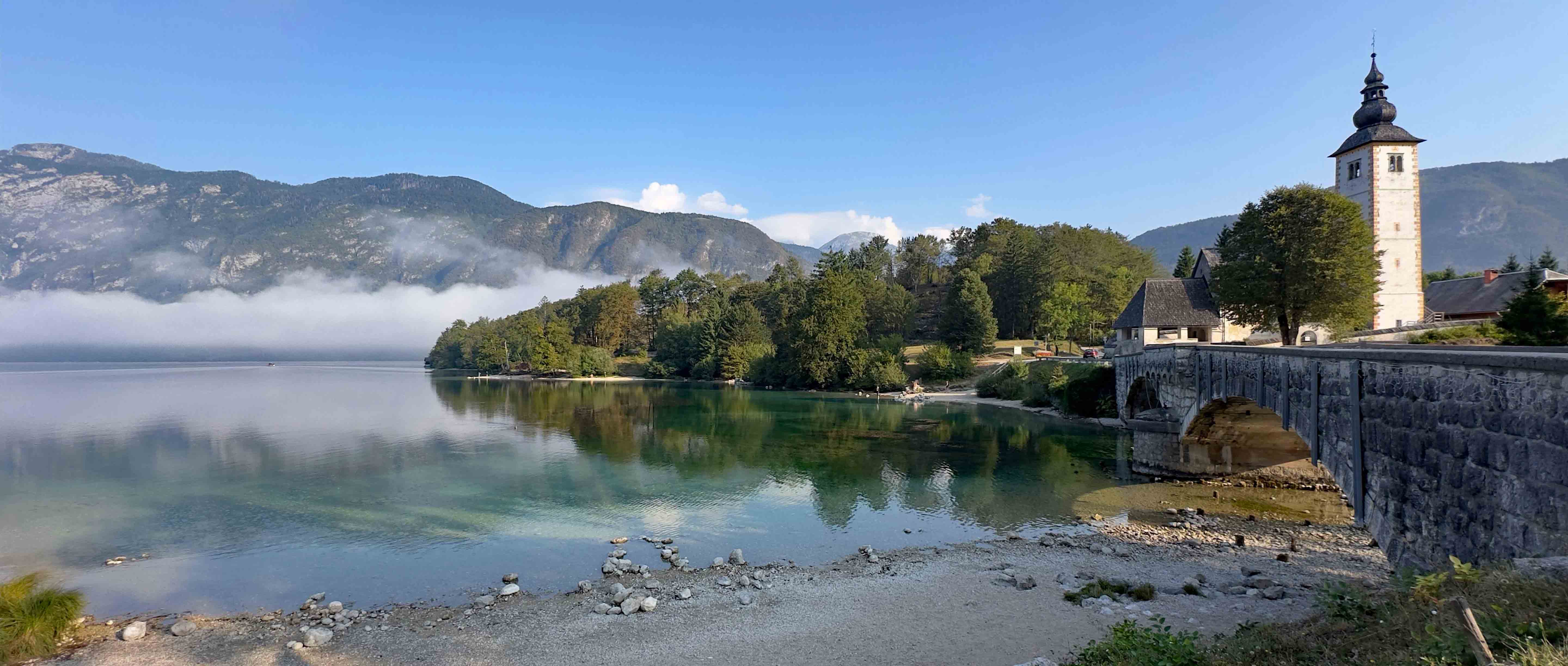
Visiting a new destination by bike offers a myriad of options – you could do it all bikepacking/touring style, you could use a mix of public transport & pedal power and then cherry pick different destinations, you could book on an organised trip/event or you could do what we did – select a couple of locations to stay in and plan multiple day rides out from your ‘base’. We initially considered using public transport to get around, but the practicalities of travelling around with heavy bike boxes and luggage in tow wasn’t that appealing, so we decided to go for a hire car instead. Some European airports (Verona, I’m looking at you) seem to specialise in eye-wateringly expensive hire car prices year-round no matter how early you book. Fortunately, Ljubljana airport was the opposite – plenty of choice at reasonable prices. With the country being so small (you could drive right across it in around four or five hours), using a car to get around was straight forward and allowed us greater flexibility.
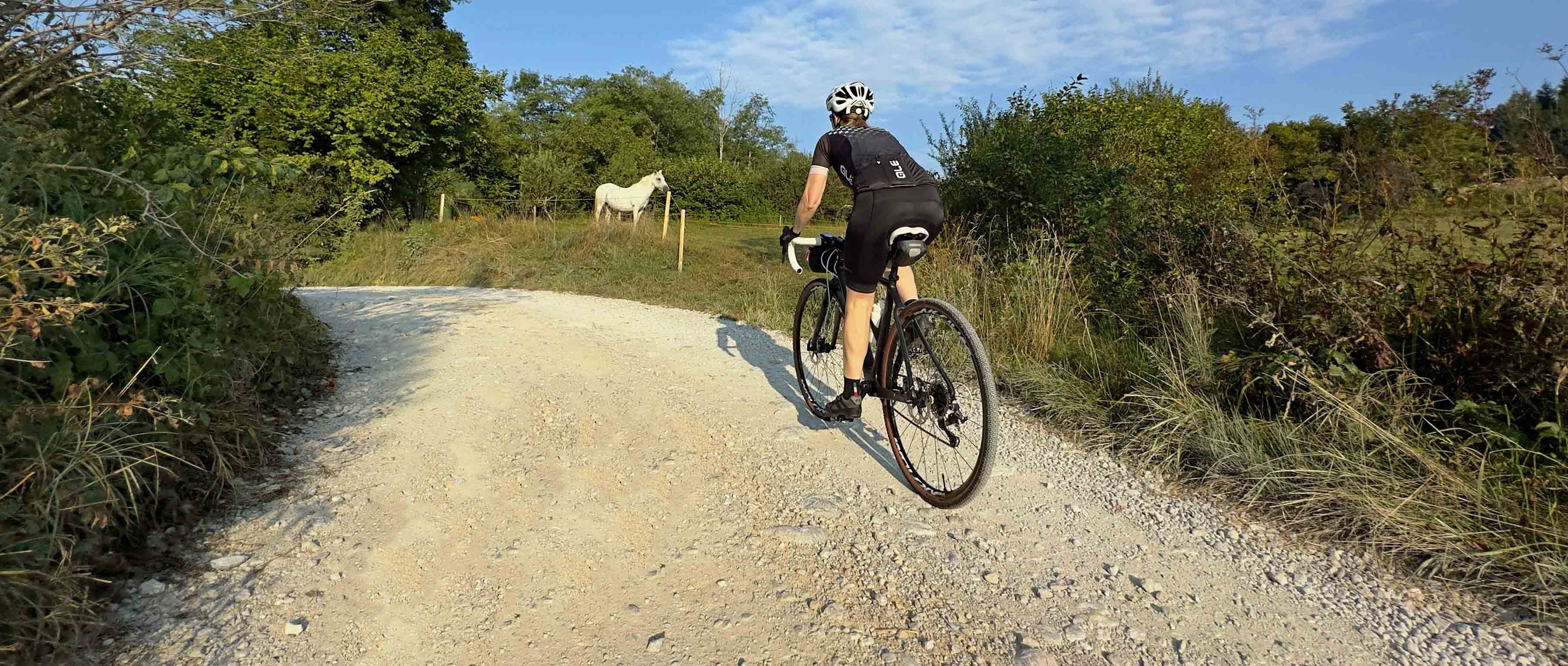
We picked two destinations – Bohinjska Bistrica in the west and Kranjska Gora in the north. We headed to Bohinjska first, with gravel riding at the top our list. Bohinjska seemed like the ideal place to base ourselves. It’s quite a small town, well connected thanks to good road and rail links and is enmeshed with a network of gravel trails. There’s stunning scenery all around with high mountains, crystal clear lakes and vast areas of broadleaf forest all within a short ride of the town. I did plenty of web research to try and figure out the best combination of trails and eventually came up with a series of day rides.
The first was a figure of eight shape and saw us head initially due west, the stunningly located Bohinjsko Jezero lake our first goal. Within five minutes riding from our apartment we had wiggled our way out of the urban area and onto a stunning crushed limestone gravel road. With the forecast for midday temperatures to be into the low 30s degrees C, we left early to try and make the most of cooler temperatures and were soon rewarded for our efforts. As we reached the summit of the first of many climbs for the day, the lake was laid out in front of us wreathed in low-lying mist.
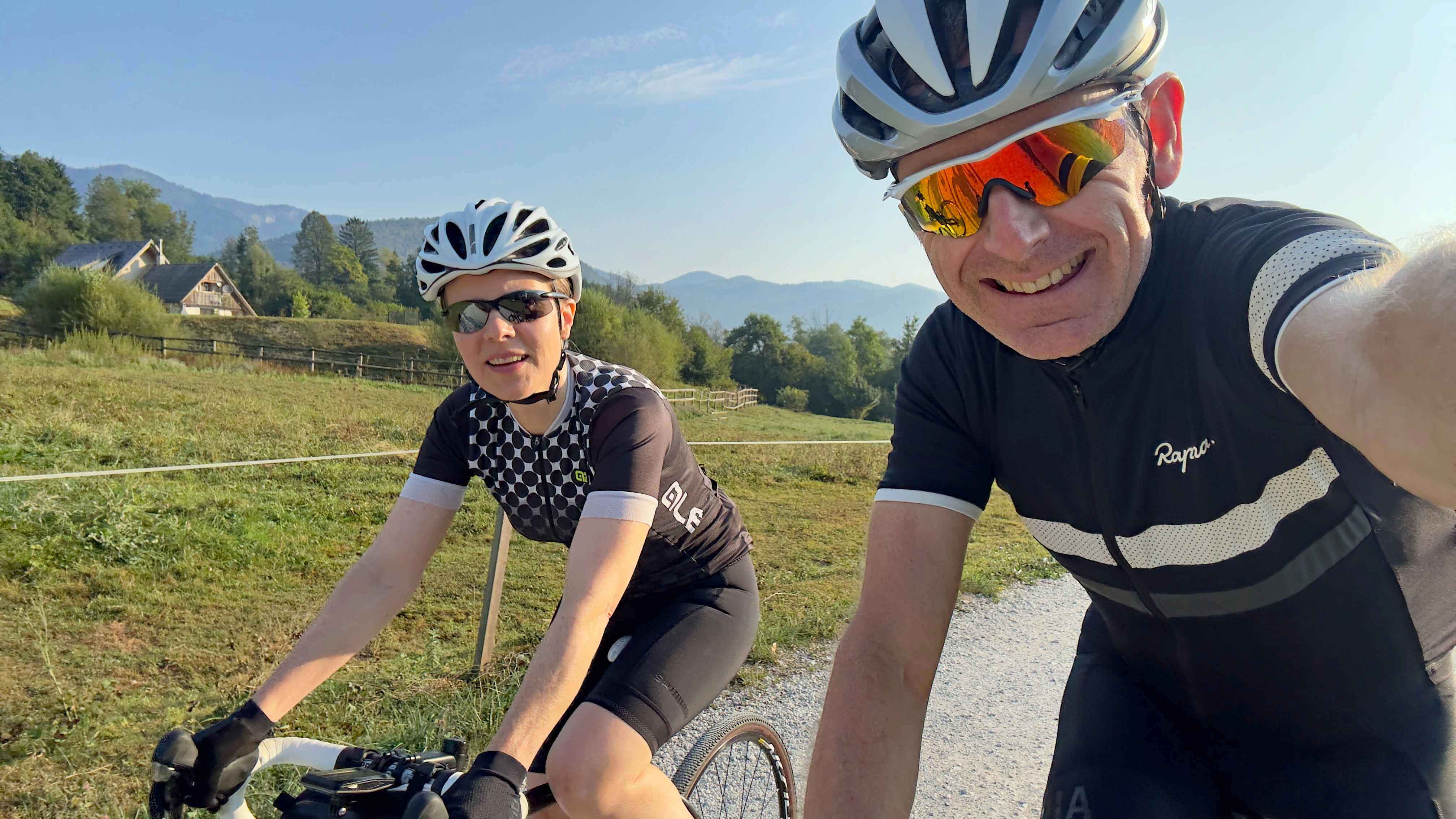
It’s always interesting to try out the trails in a new country and Slovenia didn’t disappoint. From the minute our tyres first touched a gravel road we were impressed – champagne gravel was the order of the day. Smooth, gently sweeping, traffic-free. In short, heaven. While researching options, I’d spotted plenty of waymarked multi-use trails in the area, so our route connected the gravel farm tracks with sections of immaculately paved cycling infrastructure. Every junction was signposted with guide times to different destinations. The surface was smoother than 99% of the roads in the UK and the whole thing was traffic-free. Najlepša hvala (thank you very much) Slovenia.
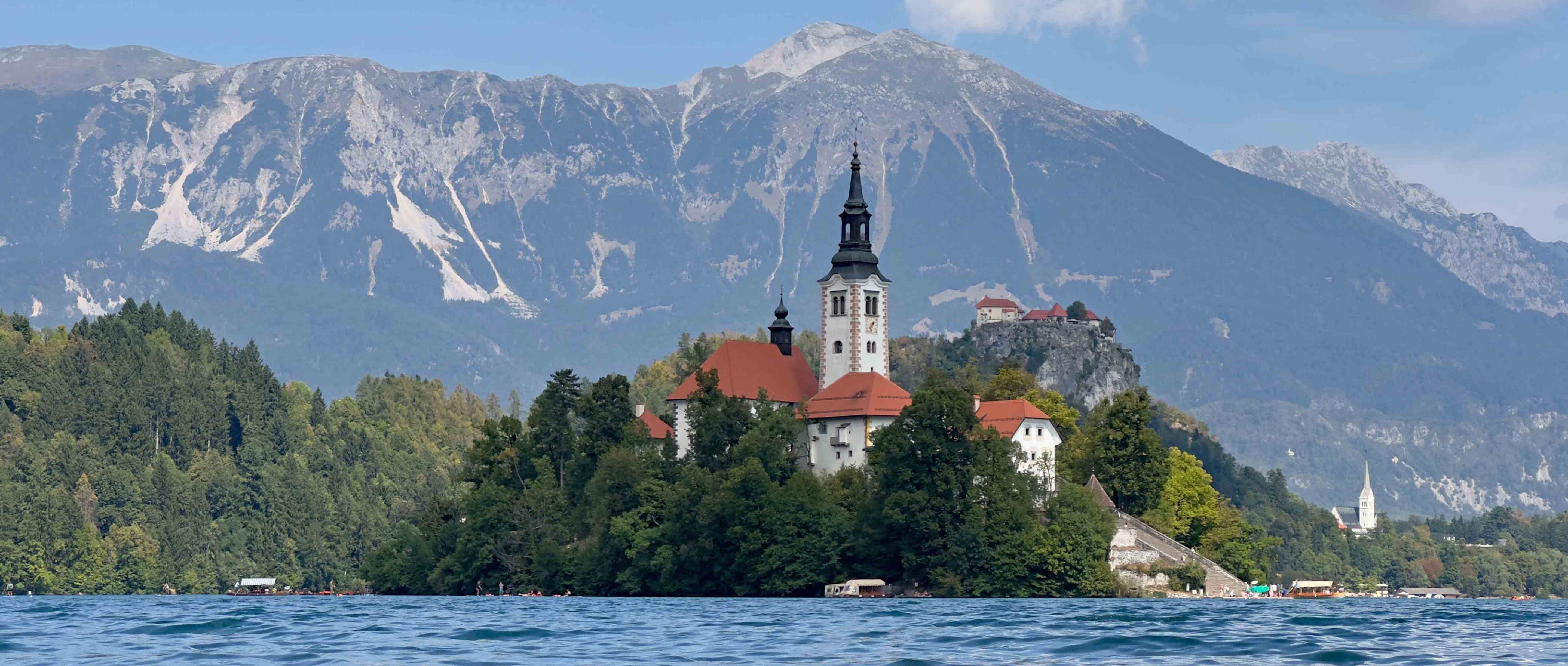
Our main destination for the ride was the tourist town of Bled. We’d deliberately decided against staying there, as it’s one of the main ‘honey-pot’ sites for visitors and was therefore super busy and dramatically more expensive. But as a destination for lunch, it was perfect. Despite the fact that we had packed gravel bikes for our trip, each route had an element of road riding in it. After a morning of gently undulating mixed gravel roads and multi-use trails, we started to head upwards and kept climbing for 10 km until we reached a 1100m high saddle near the small (and aptly named) village of Gorjuše. The climb wound its way sinuously up through beech and oak forest. Perfect tarmac, ideal temperatures, spectacular views and insignificant volumes of traffic enhanced the experience, but the best was still to come.
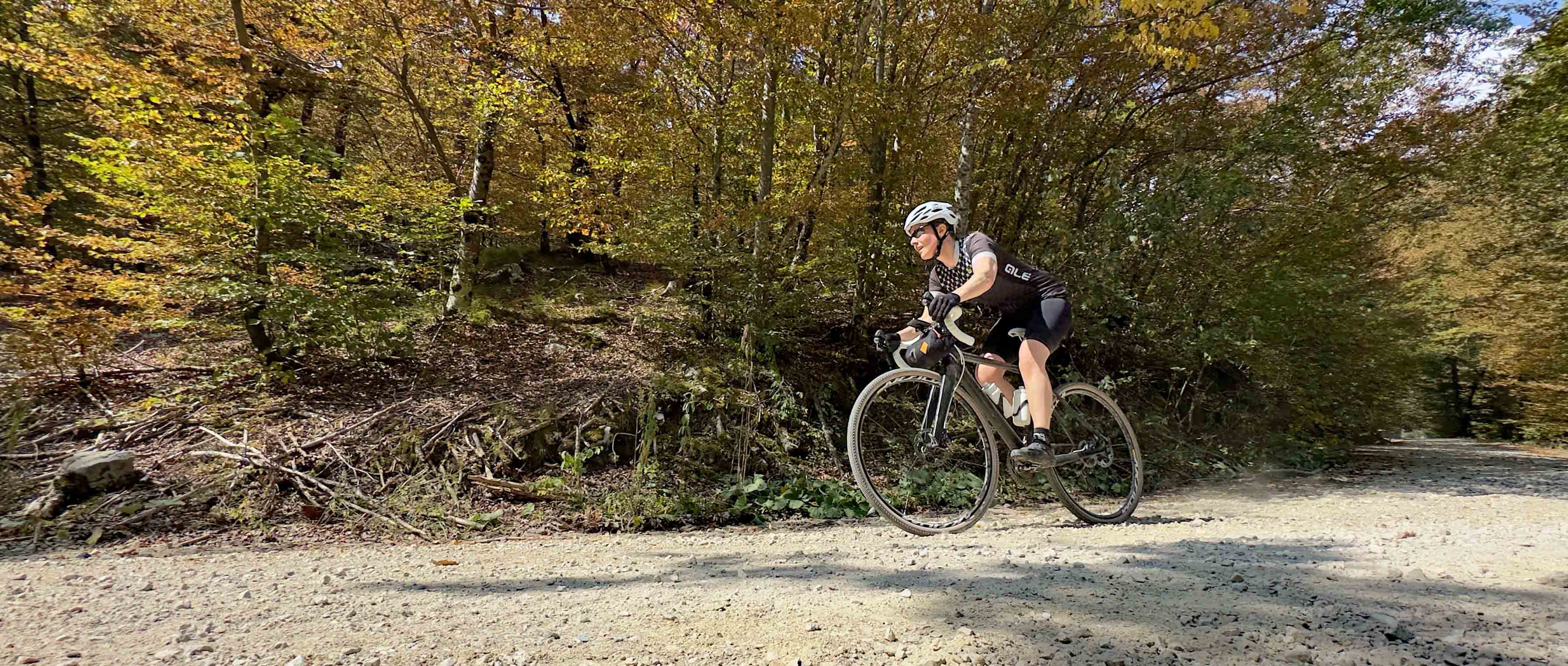
What’s the perfect antidote to a 10 km road climb? How about a fast, twisty, floaty gravel road descent down through beautifully lit broadleaf forest? Everything about the descent was perfect – twisty enough to make you concentrate, a decent surface and captivating glimpses of views through windows in the forest canopy. We arrived at the bottom absolutely buzzing and super happy with our choice of holiday destination.
Visiting Bled by bike proved to be the perfect option – there was segregated cycling infrastructure for the majority of the route into the town centre, allowing us to skip the long queues of tourist busses and hire cars also trying to disgorge their passengers into the centre of this picture-postcard destination. Bled, like the majority of places we visited in Slovenia, had a vast array of cafes and restaurants and no matter what your dietary preferences (or restrictions) are, you will most likely find something suitable. We managed to find one with outside tables shaded from the sun with a beautiful pergola.
After gently circumnavigating Lake Bled on a traffic-free, mixed-use trail, our homebound route mixed sections of minor road with sections of gravel trail. When I had been route plotting, I had identified what looked like a brand new section of mixed-use trail which was shoehorned into the steep-sided Sava Bohinjka river valley between the river, a fast looking main road and a railway. None of the usual route planning apps showed the route as anything more than a series of sporadic gravel farm tracks which would have most likely needed some hike-a-bike to link up. I spent quite a while studying some satellite images of the trails and it looked from some of them as though there was heavy machinery working on the trail. I used some intuition and crossed my fingers, hoping that the aerial images showed what I thought they did – that the farm tracks had been updated to form a contiguous mixed-use route heading west between Bled and Bohinjska.
Fortunately, my intuition was correct, although some sections of the trail were very much “under construction”. On a couple of occasions, the engineers building the new route beckoned us on around their work site, allowing us to follow the entirety of the new route despite the fact it wasn’t finished (or officially opened). The sections that had been completed were stunning – immaculate tarmac flowed like a ribbon of velvety goodness alongside the river. Our grins were so large they were probable visible from outer space. The fact that we arrived home mere seconds before a short-lived-but-fierce thunderstorm rolled down the valley was just the icing on the cake.
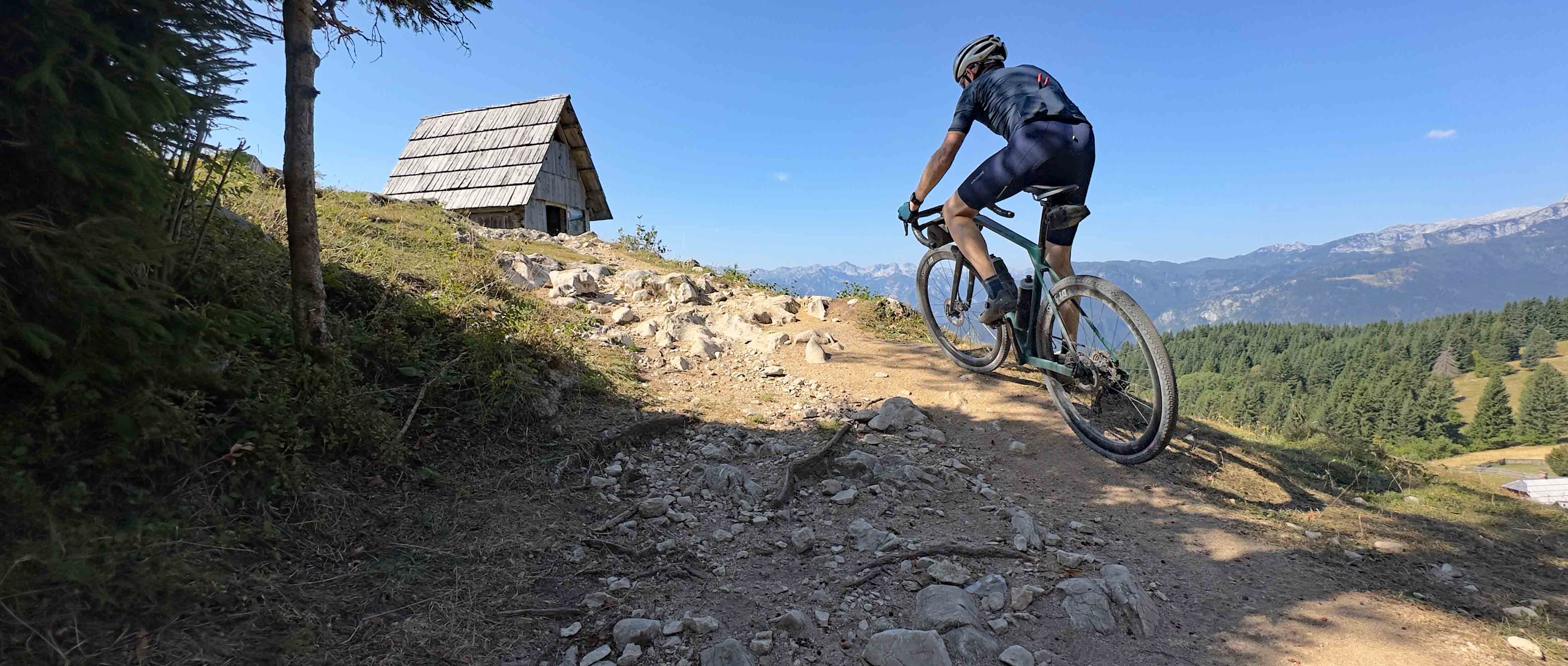
For our second ride, our destination was Planina Zajamniki – an alpine hamlet where ancient wooden shepherd’s huts (known as “planšarija”) are situated in the centre of a small flower meadow, with a stunning mountainous backdrop to look out on. The route profile was pyramid shaped – a 10 km warm-up would be followed by a 16 km gravel climb, then a steep 10 km descent and a final short, sharp climb to get over before arriving back home.
The weather forecast promised more hot sunshine, so we set off early, again riding through low-lying mist which rapidly burnt off as the sun rose and the temperature climbed. Riding the billiard-table smooth cycle path to the base of the main climb was an eerie experience – the mist damped out the sound and was quite discombobulating. We had to concentrate hard to make sure we didn’t ride into an fellow cyclists heading the opposite direction. Fortunately, we had the cycle path to ourselves and made it safely to the start of the climb proper. It started with a short paved ramp of nearly 10% gradient, before a 180 degree turn to the left led us onto gravel.
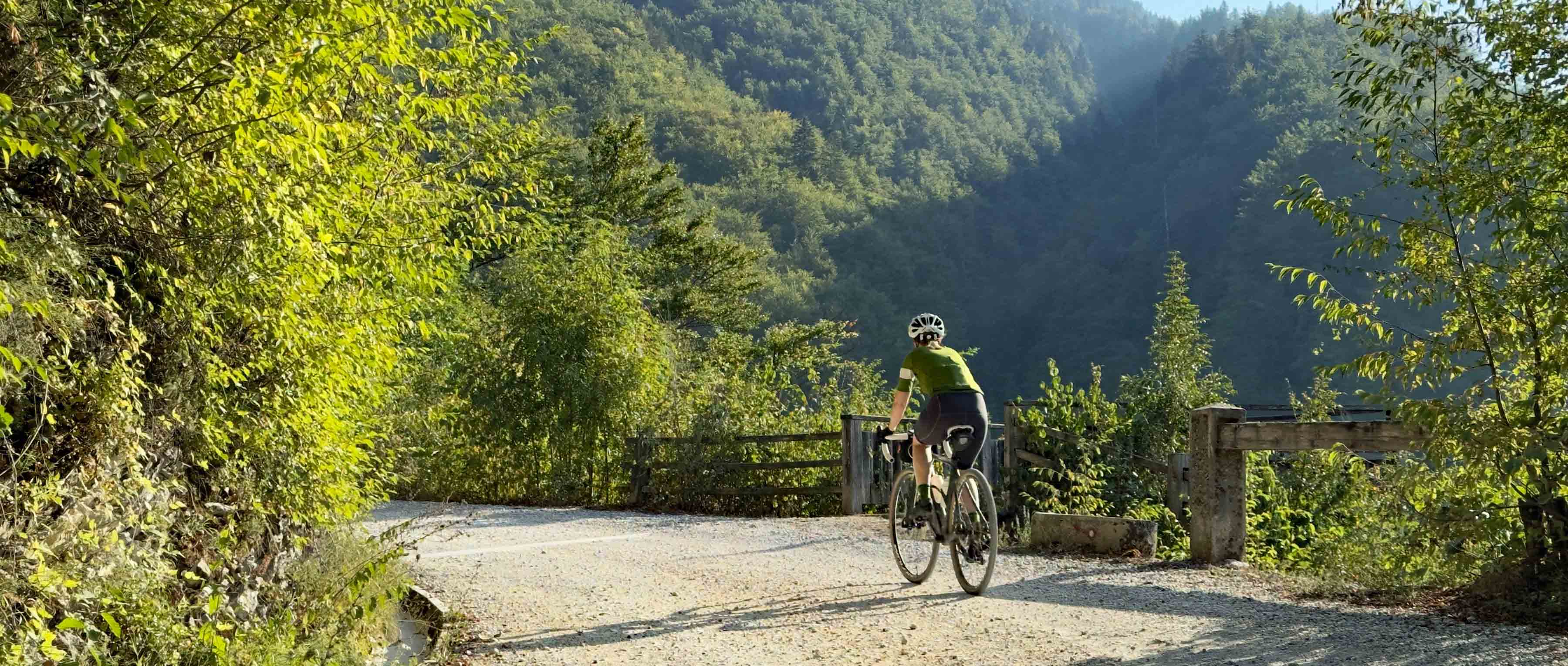
Our route zigzagged its way up through the broadleaf forest. At times, small windows in the canopy let us gaze upwards, but the summit was wrapped in a green cloak of trees, so it was hard to gauge how much further we had to climb. Fortunately much of the climb was under the shade of the forest as it was plenty tough – we gained over 800m in height over the course of 16 km. The gradient varied greatly – there were some pitches of 14-16%, but equally some sections where the route seemed to level off. What was odd, was that despite the incredible quiet, rural nature of the climb, we were passed surprisingly often by a number of small cars. The drivers were patient and gave us as much room as they could, but the loose surface and the steep gradients meant that grip was at a premium at times. It turned out that the higher reaches of the forest were home to numerous small summer homes and the cars were full of people heading into the hills for some relaxation.
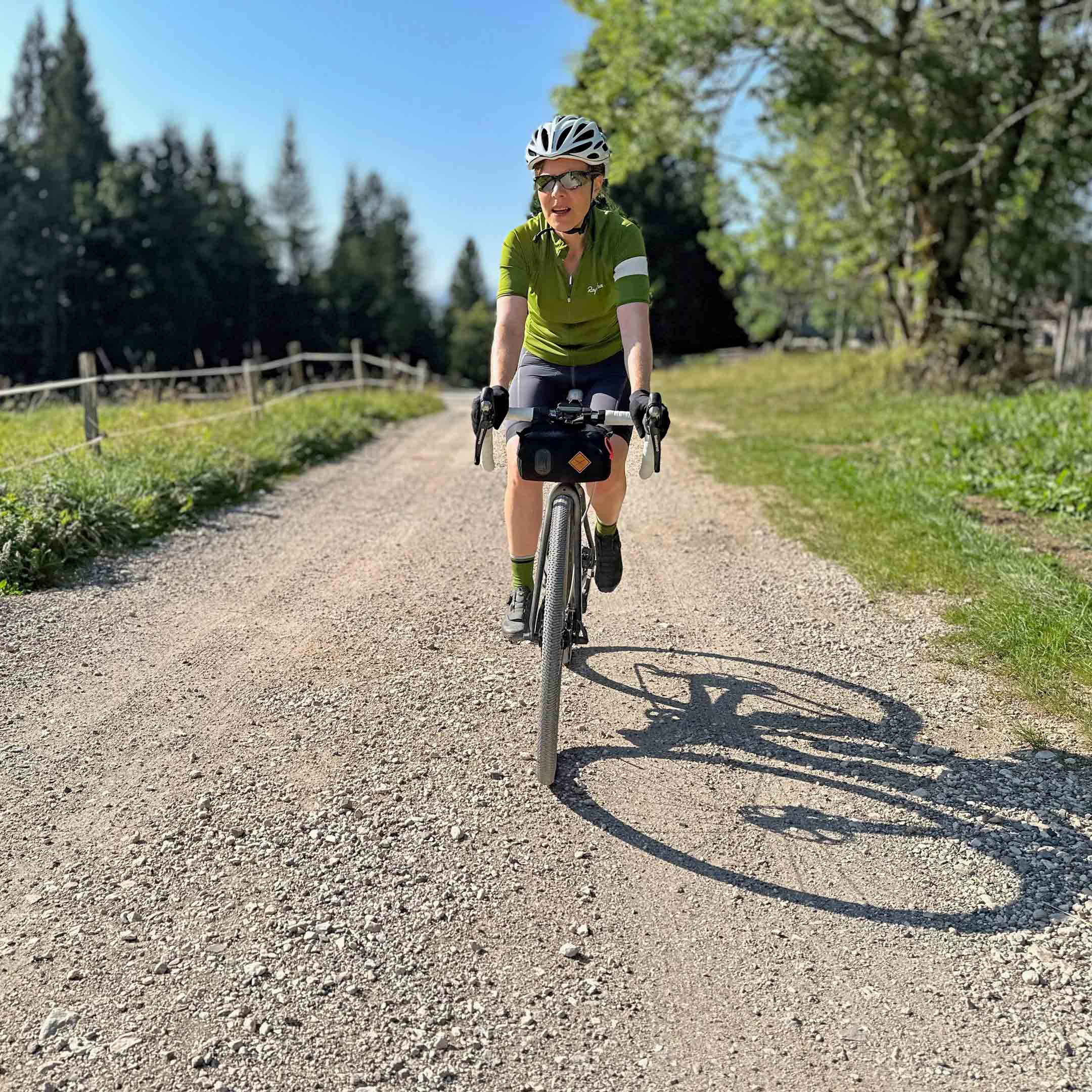
When we eventually reached the summit, there was initially quite a strong sense of anticlimax. I had expected us to pop out about the treeline and to be rewarded with a magnificent view, but the treeline in Slovenia reaches significantly higher altitudes than we were heading for. As our route started to trend downwards I had a sudden panic that we had missed Planina Zajamniki, so we stopped and double-checked the route. What I hadn’t realised when I was creating the day’s route was that the shepherd’s hut hamlet was actually off to the side of the main gravel track and that we needed to make a small detour in order to see it. By a combination of total luck, skill and fate, the track that we turned off onto brought us out on a high promontory which looked down onto Planina Zajamniki.
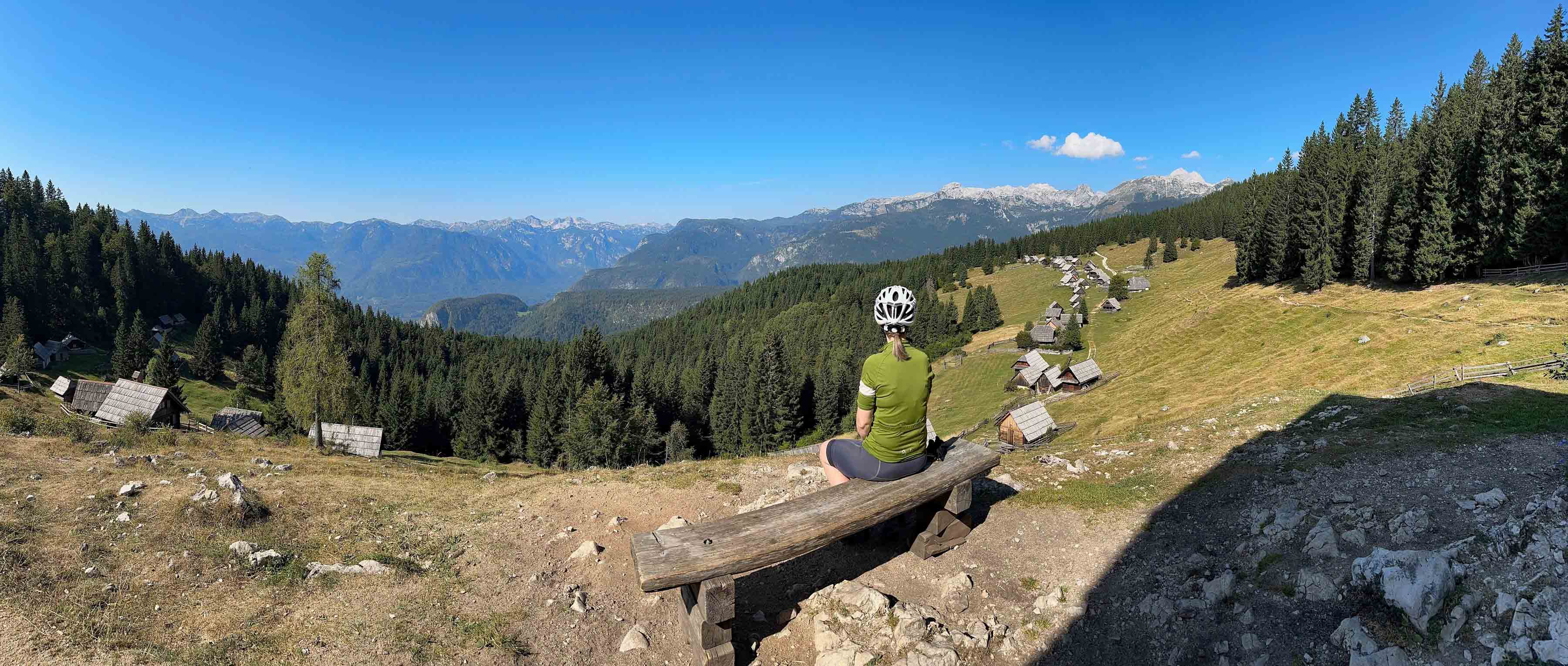
At the highest point there was a small wooden hut with a bench outside – it made the absolute perfect spot for an early lunch. The climb had been plenty hard, but the stunning view made up for the effort. After topping up our bottles at a nearby spring we headed back down to the valley bottom. The first part of the route was a gravel forest road, but it soon turned to tarmac and headed rapidly downwards, a series of 180 degree hairpin bends adding to the excitement. We’ll gloss swiftly over my badly judged “ooh, shall we just do one extra bit of trail?” which turned out to be a crazy steep climb which was baked by the sun and just say that we arrived back at our apartment safely….
With our time at an end in Bohinjska, we re-packed our stuff into the car and headed a few hours to the north-west to the alpine resort town of Kranjska Gora. Sadly the weather forecast had been predicting an incoming weather front and not long after we had checked in and unpacked at our new apartment, some ominous looking clouds started to build up over the mountains. I had planned a short ride for the afternoon which headed west of the town on an old railway, now converted into a fantastic multi-use traffic-free route and across the border into Italy, heading for a stunning alpine lake called Lago di Fusine. Unfortunately not long after we set off the heavens opened and the rain started bouncing off the floor. After a few days of hot sunshine, this was a rude awakening and we decided to turn tail and head back to our apartment.
With a slight air of despondency, we looked at as many weather forecasts as we could and tried to make sense of was predicted to happen over the next few days. All of them seemed to agree – it would stay warm, but we were in for 36 hours of cloudy conditions with frequent rain showers, which at times would be thundery, but then there would be a return to sunshine. Kranjska Gora is located a wide glaciated valley surrounded by high peaks to the south and rolling hills to the north. The town itself lies at 800m and its lofty location frequently creates its own weather. It was certainly very different ot the conditions we had experienced in the relatively low lying Bohinjska.
When I had been planning the various routes for our trip, I had spotted an incredible looking paved road climb called the Mangart Saddle. It’s slightly unusual in that it’s a dead end which finished on a high rocky ridge, so the outward and return route is the same. The upper section of the route is a toll road which significantly reduces the volume of traffic which uses it. The climb totals 1100m of vertical ascent over a distance of 10.6 km. For maths fans, that means an average gradient of more than 10%, but it has some pitches of up to 22%. You would have to be crazy to choose to come and ride it right? That’s exactly why we wanted to do it of course! The weather forecast was decidedly mixed, but it looked as though the afternoon would give us a weather window. We drove to the start by crossing first into Italy and then back in Slovenia and parked at the small carpark close to the base of the climb.
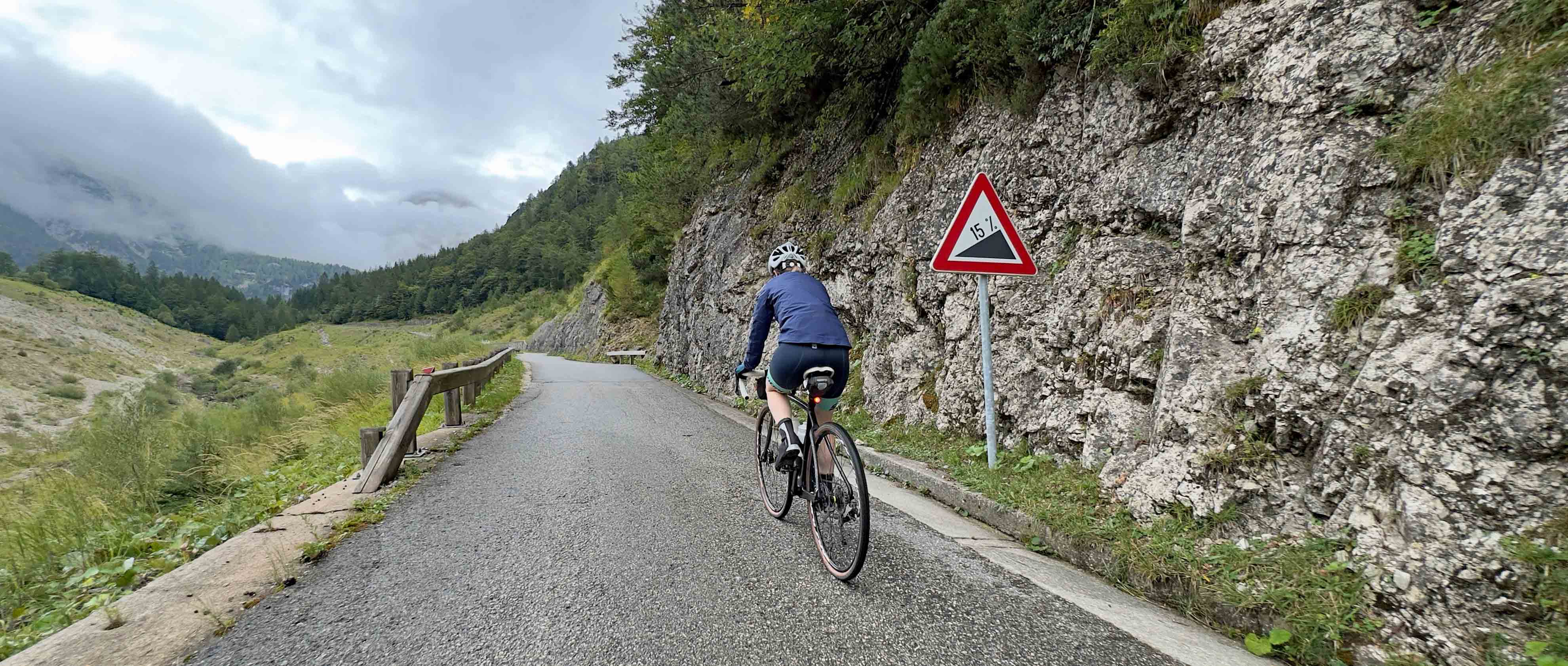
Within a few hundred metres of setting off, the gradient was more than 10% and we soon hit some sections of 15%. This is not a climb for the faint hearted! We started super slow and tried to get our legs, lungs and brains to work in sync. Initially riding with rain jackets on due to the drizzle, as we climbed, the temperature rose, but it was still pretty chilly. Fortunately the incessant gradient kept our legs warm. As we rode up to the toll booths, the guards waved us through with big smiles and said that the climb was free for cyclists (unlike vehicle drivers, who have to pay).
The route is absolutely stunning and constantly changes. There are so many hairpin bends that we lost count, but also a couple of unlit tunnels and fortunately, a few gaps in the clouds which gave us tantalising glimpses of the surrounding mountains. As we neared the high point, a gravel layby appeared out of the murk, perfectly sited for a quick snack stop. By utter luck, as we hopped off our bikes we were fortunate enough to be welcomed by a large window in the cloud. Despite the challenging gradient, we hadn’t appreciated quite how far we had climbed until we were suddenly given a glimpse down the mountain.
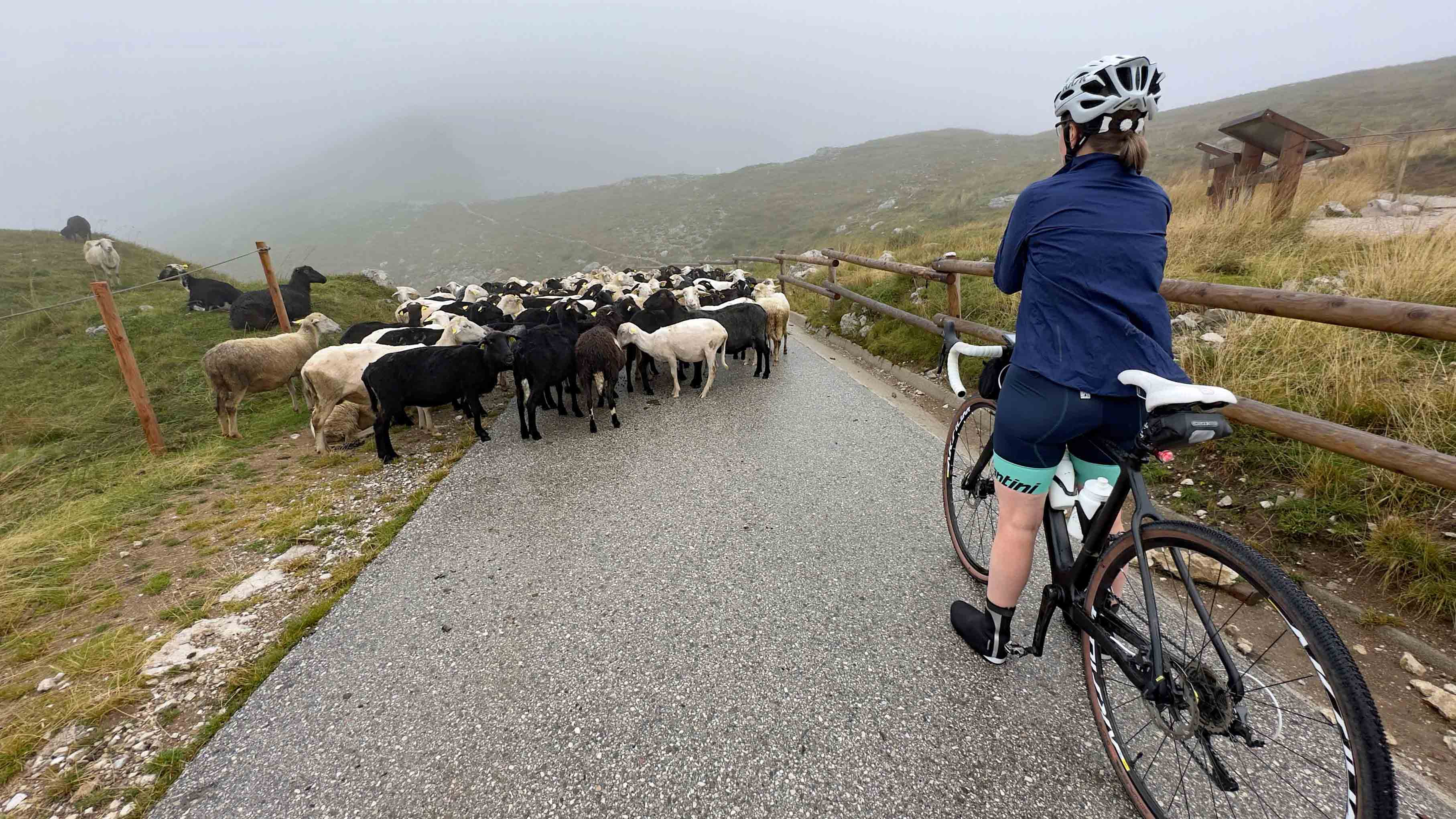
The very highest point of the route (2072m) was a bit of an anticlimax, as the clouds had rolled back in. We stopped briefly to put on extra layers, uttered a brief greeting to the sheep gathered on the road at the top and then started the impressive descent back to our start point. The lack of traffic was balanced by the mixed wet/dry road surface and the incredibly precipitous drop off the side of the road. Even trying to keep our speeds to a sensible limit, the smell of hot disc brakes followed us down the mountain. The temperature climbed seemingly with every metre we descended and as we arrived back at our car, arms aching and brains pumped, we had warmed up and our cycling kit had basically dried out. Although the route is an out-and-back and is 99% paved, I can’t praise it too highly. Obviously it will only appeal to riders looking for a decent challenge, but if you like alpine climbing, then the Mangart Saddle route should be on your list.
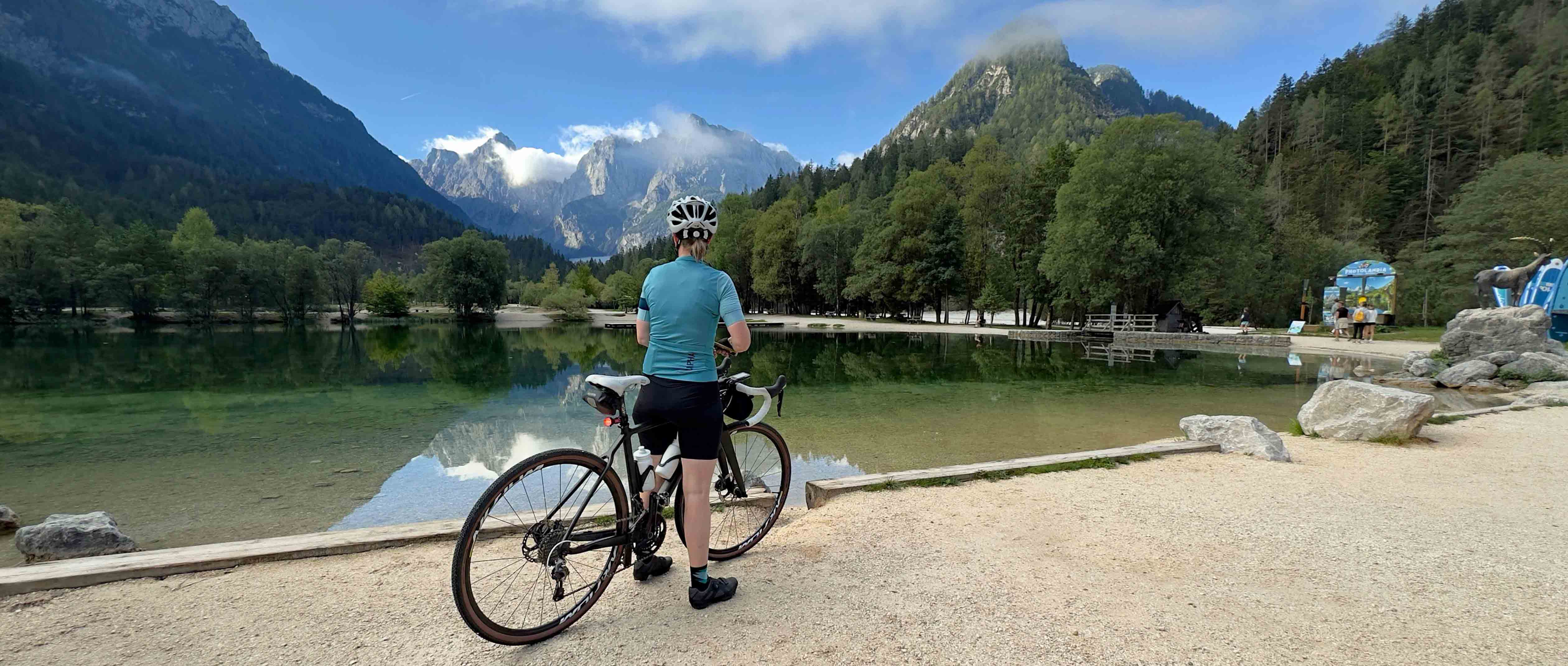
Whether it was just sheer good luck or whether it was destiny, the weather forecast for the last cycling day of our trip was perfect. Blue sky, sunshine (but not crazy hot) and no chance of rain. Back in the depths of winter when I had been route planning, I had put together a big loop from Kranjska Gora which took in two alpine passes and included everything from cobbles, to gravel singletrack to border crossings. We decided this would be the perfect way to finish our trip.
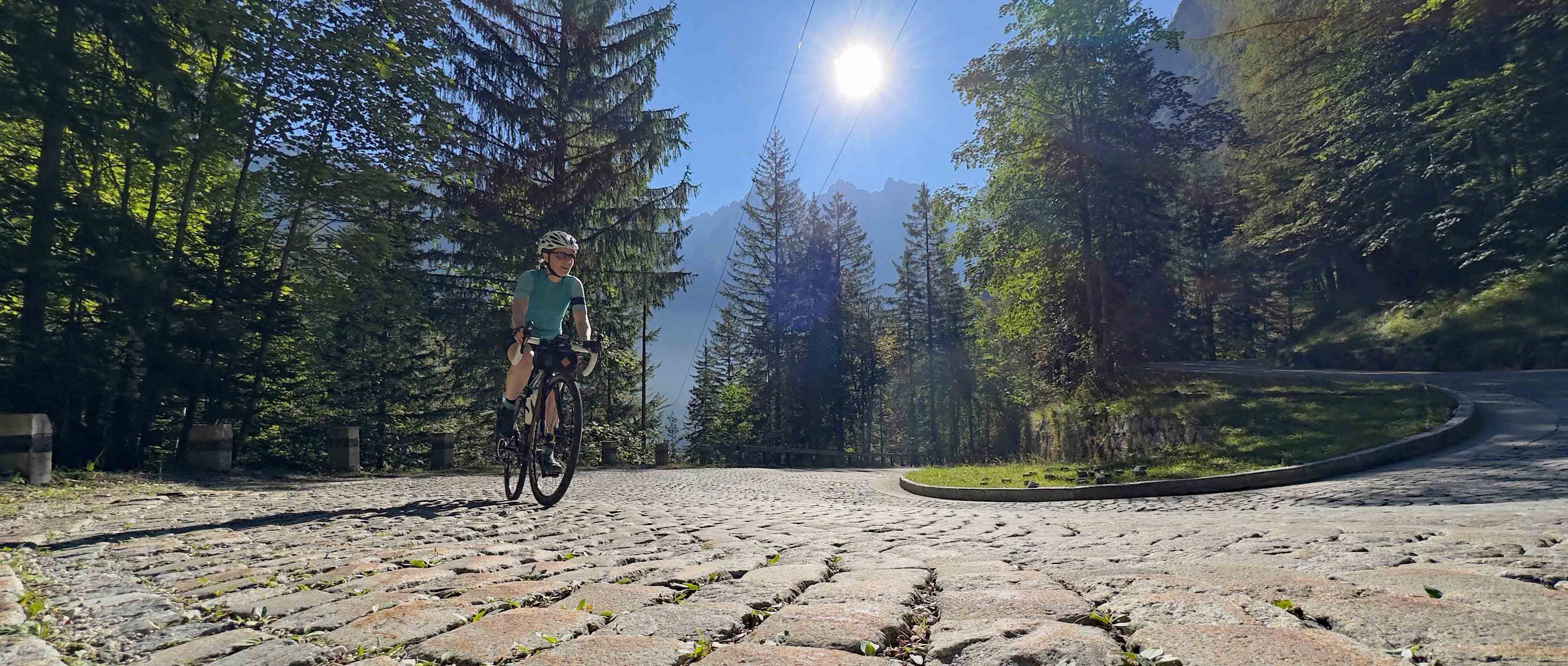
With the previous days’ wet weather now just a blip in our imagination, we woke up to perfect conditions. The mountain summits were just kissed with some early morning mist and low cloud, but this soon burnt off. Our first goal was the Vršič Pass. Standing at 1611 m, it is Slovenia’s highest road pass and has numerous cobbled hairpins on the approach from Kranjska Gora. The gradient averages around 6-7%, but there are a few steeper sections to keep you on your toes too. As well as the cobbles, the other hazard to be aware of is traffic. Unlike the Mangart Saddle, the Vršič Pass is heavily used by vehicles travelling from Kranjska Gora to the stunning Soca Valley to the south (and vice versa). Although the majority of the drivers were decent, there were a number of cockwombles in high powered sports cars who gave us the bare minimum of space and roared past in a cloud of air and noise pollution.
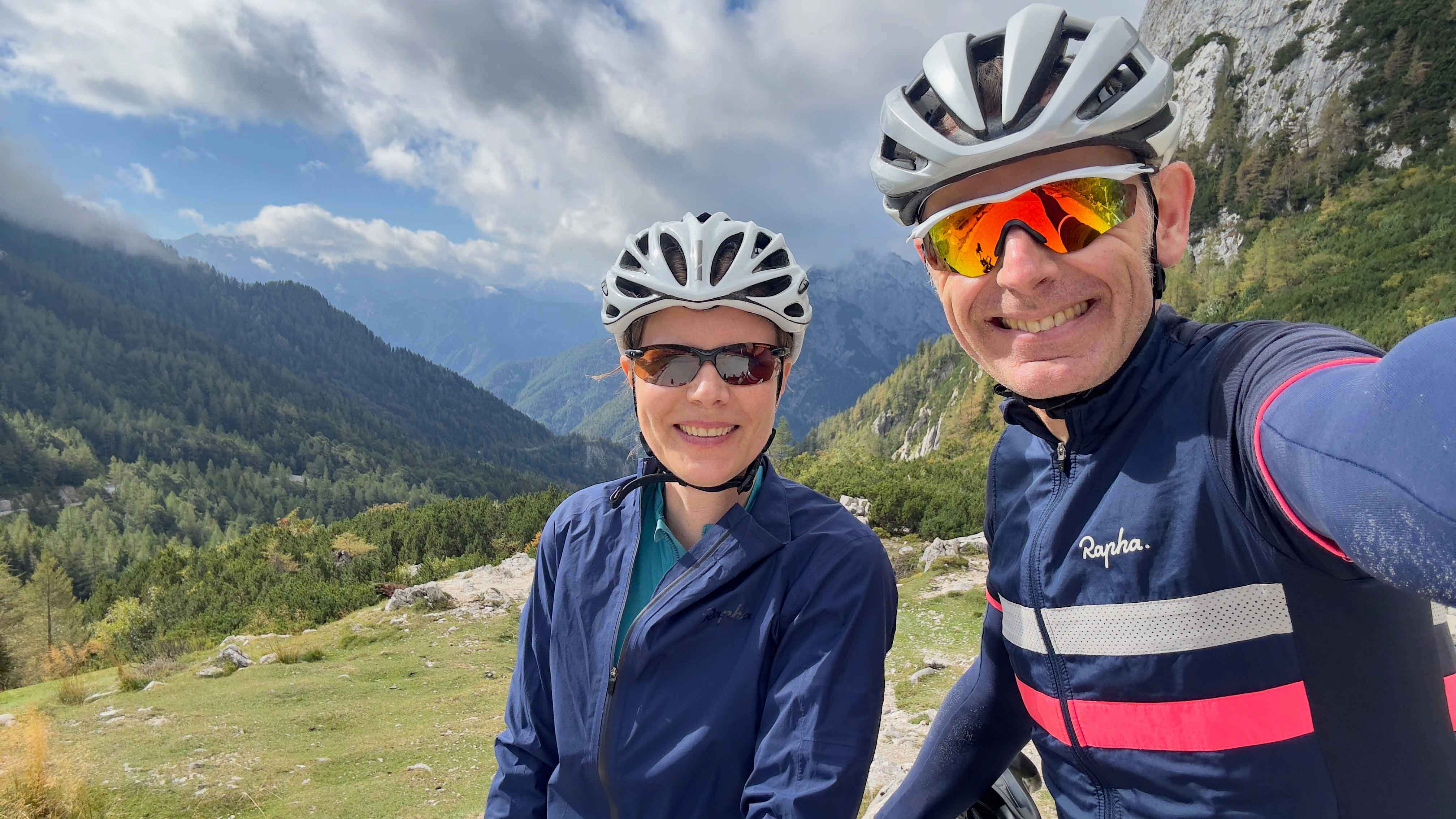
After a mandatory cheesy selfie at the highest point of the pass we headed south, bound for the stunning Soca Valley. The descent was stunning – incredibly fast and swoopy, with numerous hairpins to test our skills. It was again pretty busy with traffic, but the scenery and the riding made up for it. Our lunchtime destination was the outdoor activity town of Bovec. The whole placed hummed with the energy of visitors heading out for rafting, climbing, mountain biking, canyoning, parascending and a variety of other adrenaline-fueled sports. Fortunately we found the perfect venue for the other kind of fuel and had lunch outside in the warm sunshine.
On our route into Bovec, I had spotted some amazing looking gravel trails off to one side of the road and so after some speedy route plotting as we ate, after lunch we headed out of town on a mix of gravel, grass meadow and woodland trails – the perfect antidote to the noise of traffic on some of the nearby roads. Our destination for the early afternoon was the Italian/Slovenian border at the Passo del Predil. At 1161m, it was the high point of afternoon but it meant a 15 km climb with an altitude gain of 700m – plenty considering how full our bellies were and how hot the afternoon sun was. Fortunately the traffic seemed to diminish in the afternoon and for the first 10 km of the climb we were pretty sheltered from the wind. Unfortunately, the last section was directly into the wind, but by that point we knew we had broken the back of the climb.
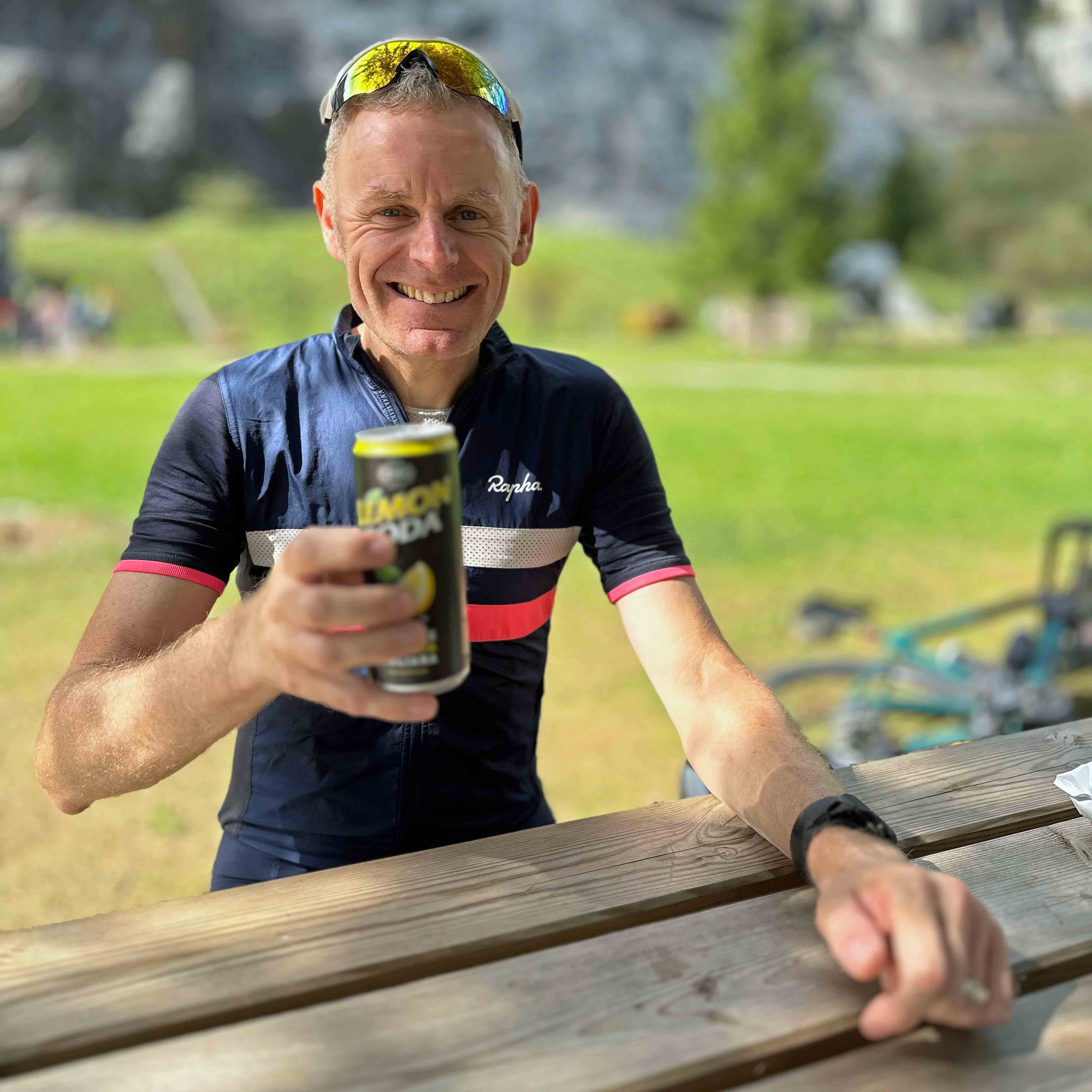
The border was open when we got there and we were welcomed with an incredibly fast, twisty descent into Italy and a date with a celebratory ice cold can of Lemon Soda.
The final section of our route took us along a section of the mind blowing Ciclovia Alpe Adria. This 415 km route links Salzburg (Austria) with Grado (Italy) and ‘our’ section was formerly an old railway line. With a screaming tailwind, stunning late afternoon sunshine and a surface smoother than any road in the UK, we hurtled our way back into Slovenia and our final destination of Kranjska Gora. After the busy roads and challenging climbing of the earlier part of the day, finishing on a wind-assisted, traffic-free route that rolled gently from Italy back into Slovenia was the perfect way to book-end our trip.
Despite sending them an invite to come and join us on our trip, we didn’t manage to come face-to-face with either Pog or Rog, but what we did find instead was stunning scenery, incredible gravel riding, challenging climbing and arguably the perfect destination for anyone looking for some gravel/road riding for their summer holidays. We’ve barely scratched the surface of this amazing place and will definitely be heading back to Slovenia in the future.
You can find the details of the four routes that we rode here: